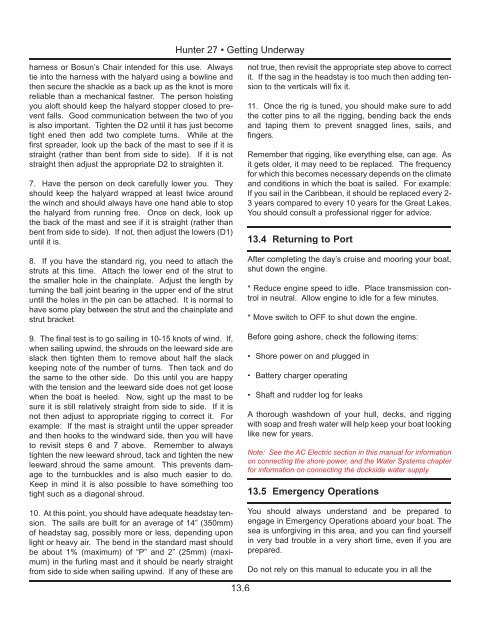27 Operator's Manual.. - Marlow-Hunter, LLC
27 Operator's Manual.. - Marlow-Hunter, LLC
27 Operator's Manual.. - Marlow-Hunter, LLC
Create successful ePaper yourself
Turn your PDF publications into a flip-book with our unique Google optimized e-Paper software.
<strong>Hunter</strong> <strong>27</strong> • Getting Underway<br />
harness or Bosun’s Chair intended for this use. Always<br />
tie into the harness with the halyard using a bowline and<br />
then secure the shackle as a back up as the knot is more<br />
reliable than a mechanical fastner. The person hoisting<br />
you aloft should keep the halyard stopper closed to prevent<br />
falls. Good communication between the two of you<br />
is also important. Tighten the D2 until it has just become<br />
tight ened then add two complete turns. While at the<br />
first spreader, look up the back of the mast to see if it is<br />
straight (rather than bent from side to side). If it is not<br />
straight then adjust the appropriate D2 to straighten it.<br />
7. Have the person on deck carefully lower you. They<br />
should keep the halyard wrapped at least twice around<br />
the winch and should always have one hand able to stop<br />
the halyard from running free. Once on deck, look up<br />
the back of the mast and see if it is straight (rather than<br />
bent from side to side). If not, then adjust the lowers (D1)<br />
until it is.<br />
8. If you have the standard rig, you need to attach the<br />
struts at this time. Attach the lower end of the strut to<br />
the smaller hole in the chainplate. Adjust the length by<br />
turning the ball joint bearing in the upper end of the strut<br />
until the holes in the pin can be attached. It is normal to<br />
have some play between the strut and the chainplate and<br />
strut bracket.<br />
9. The final test is to go sailing in 10-15 knots of wind. If,<br />
when sailing upwind, the shrouds on the leeward side are<br />
slack then tighten them to remove about half the slack<br />
keeping note of the number of turns. Then tack and do<br />
the same to the other side. Do this until you are happy<br />
with the tension and the leeward side does not get loose<br />
when the boat is heeled. Now, sight up the mast to be<br />
sure it is still relatively straight from side to side. If it is<br />
not then adjust to appropriate rigging to correct it. For<br />
example: If the mast is straight until the upper spreader<br />
and then hooks to the windward side, then you will have<br />
to revisit steps 6 and 7 above. Remember to always<br />
tighten the new leeward shroud, tack and tighten the new<br />
leeward shroud the same amount. This prevents damage<br />
to the turnbuckles and is also much easier to do.<br />
Keep in mind it is also possible to have something too<br />
tight such as a diagonal shroud.<br />
10. At this point, you should have adequate headstay tension.<br />
The sails are built for an average of 14” (350mm)<br />
of headstay sag, possibly more or less, depending upon<br />
light or heavy air. The bend in the standard mast should<br />
be about 1% (maximum) of “P” and 2” (25mm) (maximum)<br />
in the furling mast and it should be nearly straight<br />
from side to side when sailing upwind. If any of these are<br />
not true, then revisit the appropriate step above to correct<br />
it. If the sag in the headstay is too much then adding tension<br />
to the verticals will fix it.<br />
11. Once the rig is tuned, you should make sure to add<br />
the cotter pins to all the rigging, bending back the ends<br />
and taping them to prevent snagged lines, sails, and<br />
fingers.<br />
Remember that rigging, like everything else, can age. As<br />
it gets older, it may need to be replaced. The frequency<br />
for which this becomes necessary depends on the climate<br />
and conditions in which the boat is sailed. For example:<br />
If you sail in the Caribbean, it should be replaced every 2-<br />
3 years compared to every 10 years for the Great Lakes.<br />
You should consult a professional rigger for advice.<br />
13.4 Returning to Port<br />
After completing the day’s cruise and mooring your boat,<br />
shut down the engine.<br />
* Reduce engine speed to idle. Place transmission control<br />
in neutral. Allow engine to idle for a few minutes.<br />
* Move switch to OFF to shut down the engine.<br />
Before going ashore, check the following items:<br />
• Shore power on and plugged in<br />
• Battery charger operating<br />
• Shaft and rudder log for leaks<br />
A thorough washdown of your hull, decks, and rigging<br />
with soap and fresh water will help keep your boat looking<br />
like new for years.<br />
Note: See the AC Electric section in this manual for information<br />
on connecting the shore power, and the Water Systems chapter<br />
for information on connecting the dockside water supply.<br />
13.5 Emergency Operations<br />
You should always understand and be prepared to<br />
engage in Emergency Operations aboard your boat. The<br />
sea is unforgiving in this area, and you can find yourself<br />
in very bad trouble in a very short time, even if you are<br />
prepared.<br />
Do not rely on this manual to educate you in all the<br />
13.6

















